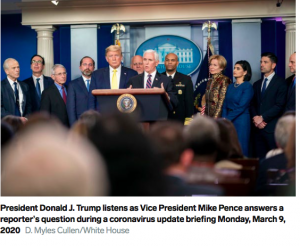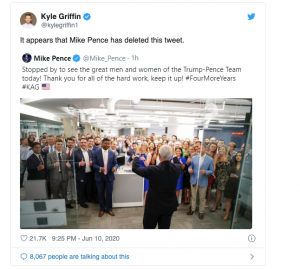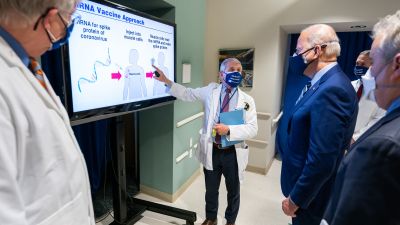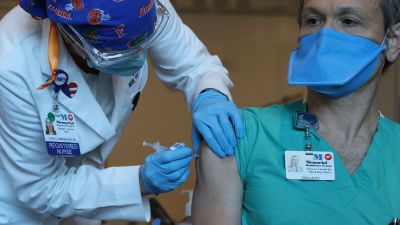
White House Flickr
The Centers for Disease Prevention and Control recommends that all Americans practice social distancing to protect themselves and others from COVID-19. Trump has been systematically undermining that CDC guidance.
Ignoring Science at the Expense of Public Health
Mar. 9: The CDC has recommended social distancing and avoiding crowds to mitigate the spread of COVID-19 and protect those at highest risk. But here’s a photo of the day’s White House Coronavirus Force briefing:

Mar. 13: At today’s White House Coronavirus Task Force press briefing, Trump declares the pandemic a national emergency. But as with all previous briefings, he fails to follow the CDC’s social distancing guidelines, shaking hands with more than a dozen industry leaders appearing with him on stage:

From another angle:

Mar. 16: The White House Correspondents Association, which is responsible for assigning seats in the White House briefing room, adopts a rule to increase social distancing by reducing the number of reporters present and rearranging the seating.
May 29: Trump tells Gov. Roy Cooper (D-NC) that if the upcoming Republican National Convention planned for Charlotte on Aug. 24-27 does not permit the massive audiences that Trump loves, he will move it to another state. At the time, the seven-day average of confirmed COVID-19 cases and hospitalizations in North Carolina is increasing.
“Since the day I came down the escalator, I’ve never had an empty seat and I find the biggest stadiums,” Trump tells the governor. “I don’t want to be sitting in a place that’s 50 percent empty.”
According to later reporting by The Washington Post, “Trump had a blunt response to Cooper’s reminders about the potential cost of crowding so many people into a closed arena. ‘We can’t do social distancing,’ the president said.…‘We can’t do scaled down.’” Trump casually dismisses any health concerns that might arise from squeezing thousands of supporters — wearing masks only if they choose — inside an arena to hear his acceptance speech.
That same day, Trump calls Gov. Ron DeSantis (R-FL) to see whether Florida might host the convention on Trump’s terms. At the time, Florida is experiencing its largest single-day increase of COVID-19 infections in a month.
June 5: After the WHCA adopted its social distancing rule on Mar. 15, the White House set up reporters’ chairs accordingly. But on this day, after the seats are initially arranged in that way, the White House orders them moved closer together:
The news conference was initially set up for social distancing. Then the WH rearranged the chairs. Before and after pics from our @abdallahcnn pic.twitter.com/jxKAneAZsy
— Jim Acosta (@Acosta) June 5, 2020
As the briefing begins, Trump says, “I noticed you’re starting to get much closer together. Looks much better, I must say.” Asked later about the abandonment of social distancing for reporters at the briefing, the White House press office echoes Trump, saying, “It looks better.”
June 10: Pence visits the Trump-Pence campaign staff and tweets a photo showing no one wearing a mask and no social distancing by the workers. Then he deletes it:

Also on June 10: Trump announces that he will resume campaign rallies on June 19 in Tulsa. “They’ve done a great job with COVID, as you know, in the state of Oklahoma,” he says. The truth is that new COVID-19 cases in that state have increased in recent days and the 14-day trend is upward.
Trump also says that he plans campaign stops in Florida, Texas, Arizona and North Carolina — states where new COVID-19 infections are also increasing.
June 11: The Trump campaign website posts an online registration form for individuals seeking tickets to Trump’s rally in Tulsa. It requires attendees to acknowledge the “inherent risk of exposure to COVID-19 exists in any public place where people are present.“ By attending the rally, they “voluntarily assume all risks related to exposure to COVID-19” and agree not to hold the Trump campaign or the venue’s owners and managers liable for any illness of injury.
June 11: The RNC announces that Trump’s acceptance speech and other key convention events will move from Charlotte, North Carolina to Jacksonville, Florida, where Trump will speak at a venue that accommodates up to 15,000 people.
The same day, Florida reports its biggest ever one-day jump in COVID-19 cases — 1,700.
June 12: During the CDC’s first full briefing with reporters in more than three months, it discusses newly released guidelines recommending that people continue to maintain a distance of six feet from others whenever possible, wear face coverings in public, and wash their hands. The guidelines specifically identify the “highest risk” category for COVID-19 transmission: “Large in-person gatherings where it is difficult for individuals to remain spaced at least 6 feet apart and attendees travel from outside the local area.”
Asked if the guidelines apply to campaign rallies, Dr. Jay Butler, the CDC’s deputy director for infectious diseases, says the regulations speak for themselves: “They are not regulations. They are not commands”.
Public Health Enemy #1
Trump is undermining CDC guidance and public health so he can deliver a tragically misguided message: Mission accomplished! The pandemic is over! Return to business as usual! Go to work! Revive the economy! Come to a rally!
He hopes the country will ignore the fact that the virus — which has already claimed more than 115,000 American lives — is still causing as many as 800 deaths every day. On June 10, the head of Harvard’s Global Health Institute predicted that the US would surpass 200,000 COVID-19 deaths sometime in September. Only six countries in the world have more deaths per million of population. None comes close to America’s staggering absolute total.
For the sake of personal optics, Trump is evidently willing to sacrifice the wellbeing of even his most fervent supporters — the ones who show up at campaign rallies. There is no price too high for anything that might enhance his re-election prospects — provided someone else pays it.





